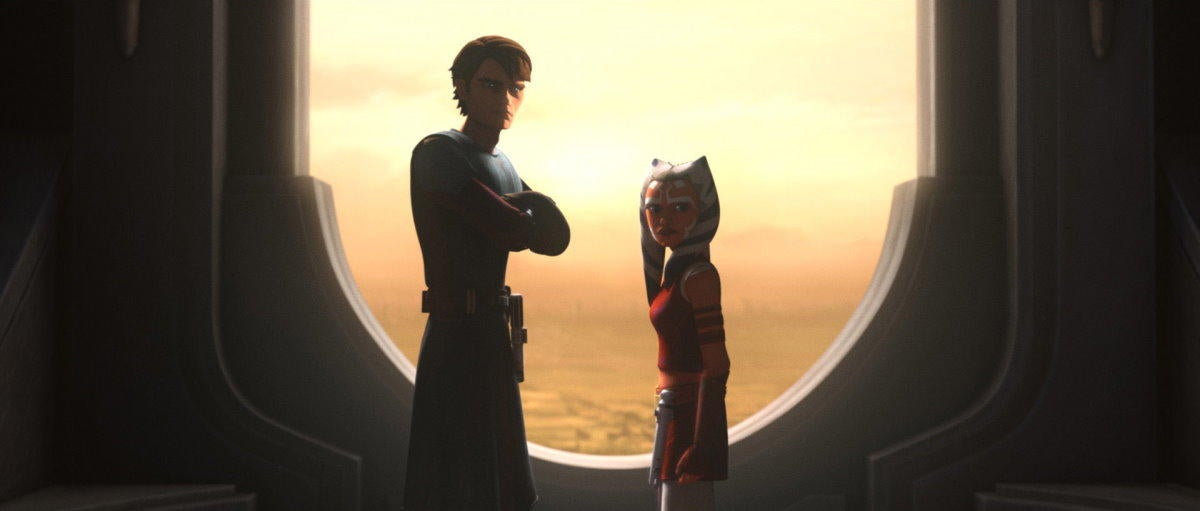Star Wars: Tales of the Jedi Review: Star Wars at Its Moody Best
Star Wars returns to CG animation with Tales of the Jedi, a series of six shorts released simultaneously on Disney+. Despite the short-form format, everything that Dave Filoni and Lucasfilm Animation perfected through Star Wars: The Clone Wars and Star Wars Rebels remains intact and on display. Compared to those series, Tales of the Jedi is a somber experience, lacking the rousing score, epic wartime battles, and clandestine sabotage missions. Instead, it perfectly sets a tone that befits its character-focused story, touching on the Jedi blindspots that allowed the Dark Side to thrive in the years leading to the rise of the Empire via the lives of two Jedi who saw and experienced those failings and responded to them in different ways.
Tales of the Jedi's six episodes split their focus evenly between Ahsoka Tano and Count Dooku, earning three episodes for each. Since Lucasfilm ordered the episodes chronologically, Dooku's story is couched within Ahsoka's, entwining them in a way that creates a cohesive narrative.

The first episode, "Life and Death," shows Ahsoka's birth and the ceremonial first hunting trip with her mother, which reveals her Force sensitivity. It's the quietest of all the episodes, featuring not a single lightsaber, opting instead to reconnect the concept of the Force with the inspiration from Eastern philosophies and religions like Taoism that informed its depiction in the original Star Wars trilogy. The episode achieves this in a way that moves the viewer and recalibrates the baseline for what balance in the Force means, something that both Jedi and Star Wars fans sometimes forget, thus setting the stage for the episodes to come.
After this, Tales of the Jedi begins a three-episode arc charting Count Dooku's fall to the Dark Side. Each episode takes place years apart at key points in Dooku's descent, from his first dissatisfaction with the Jedi's role in the Republic to his first exposure to Separatist politics to his crossing of the threshold at the point of no return. Each time he is paired with another Jedi -- Qui-Gon Jinn, Mace Windu, and Yaddle -- to contrast his thoughts and behaviors with theirs. The episodes form an inversion of the "Hero's Journey" that served as the narrative basis for the original Star Wars trilogy, as Dooku ultimately answers the call of the Sith.
Tales of the Jedi closes with two episodes focused on Ahsoka, condensing a similar three-act arc story into two episodes via allusions to events from Star Wars: The Clone Wars. "Practice Makes Perfect" may inspire discussion about the training style of Ahsoka's master, Anakin Skywalker, as thoughtful viewers will consider what's under the surface: Who sent a 14-year-old girl to be a wartime commander in the first place? And why is Ahsoka among the only Jedi to survive Order 66?
The final episode points toward what comes next for Ashoka in the era of the Empire, providing her with a moment similar to Obi-Wan Kenobi's duel with Darth Maul in the Star Wars Rebels episode "Twin Suns." The moment concisely sums up all of her growth and all the strength she's gained through her training and experiences into a single moment of fluid, fast, and almost casually precise yet intense action that may take viewers by surprise.
Ashley Eckstein and Corey Burton lead the series as Ahsoka and Dooku and provide more of the same excellent performances they gave in past animated series. They also offer subtle variations to match the eras of each episode, be it Eckstein lowering her register slightly when portraying the older, wearied Ahsoka or Burton giving Dooku more of the intensity of youth in his earlier days. The supporting actors give mostly stellar performances, including Bryce Dallas Howard as Yaddle. It's a performance packed with the dignity, strength, and surprising vulnerability befitting a Jedi council member once you get past the shock of, "Oh, that's what she sounds like, and not like Yoda?" The only performance that misses the mark is Micheál Richardson as young Qui-Gon Jinn, whose naturalistic speech is out of place among the bolder deliveries given by the veterans of cartoon storytelling.
All of these references to the philosophical underpinnings of Star Wars and the other animated shows may make it sound like Tales of the Jedi is for fans only and an impenetrable web of cross-references for the uninitiated. That's not the case. Similarly, the small scale of Tales of the Jedi compared to other animated entries in the franchise may put off established fans, but they would also be missing the mark. The 10-15 minute run times of these six episodes, set at moments away from the grander sweeps of the Star Wars space opera, allow Filoni and his team to employ a more elegant storytelling style, relying more on atmosphere and mood than on action. It puts the group's storytelling artistry on display in a way that even Star Wars novices can appreciate while delivering stories that, for all their subtlety, still cut deep enough to penetrate even a jaded Star Wars veteran's defenses.
These six Tales of the Jedi are beautiful, moving, and deceptively layered for their brevity while packing a few surprises and jaw-dropping moments along the way. Lucasfilm Animation managed to squeeze a lot of Star Wars magic into these shorts, and viewers will only be disappointed that there aren't more of them.
Ratings: 4 out of 5
Star Wars: Tales of the Jedi is streaming now on Disney+
0comments